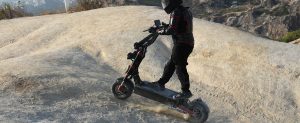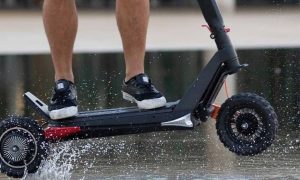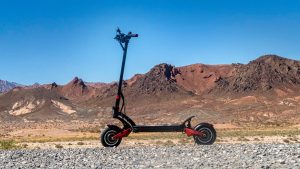Yes, electric scooters can climb hills, with power and design affecting their ability.
The Mechanics of Electric Scooters
Electric scooters have surged in popularity as an eco-friendly alternative to traditional motor vehicles for navigating urban environments. These compact devices offer a convenient way to cover short distances quickly and with minimal physical effort.
How Electric Scooters Work
Electric scooters operate on a straightforward principle: a rechargeable battery powers a motor, which in turn propels the scooter forward. When a rider pushes the throttle, the electric motor—typically located in the hub of one of the wheels or mounted to the frame—draws power from the battery. This process activates the motor’s internal windings, creating a magnetic field that pushes against the permanent magnets in the motor, causing rotation. This rotation is then directly transferred to the wheels, or through a chain, driving the scooter forward.
The efficiency of this system is paramount. Electric scooters are designed to maximize the conversion of electrical energy into kinetic energy, reducing energy loss through heat and friction. This efficiency is measured by the power rating of the motor, typically ranging from 250 watts for basic models to over 2000 watts for high-performance scooters.
Motor Types and Power
The type of motor an electric scooter uses can significantly impact its performance. There are two primary types of motors used in electric scooters:
- Brushed DC Motors: These are simpler and cheaper but less efficient because they require regular maintenance to replace worn-out brushes.
- Brushless DC Motors (BLDC): These motors are more efficient, have a longer lifespan, and require less maintenance since they do not have brushes that wear out. The absence of brushes allows for better speed variability and a higher power-to-weight ratio.
When considering the power of an electric scooter’s motor, one must look at both the peak power and the sustained power output. Peak power is the maximum power the motor can produce in short bursts, which is crucial for acceleration and climbing hills. Sustained power is the power level that the motor can maintain over time, which is important for maintaining speed and ensuring long battery life. On average, a 500-watt motor is sufficient for most urban environments, whereas climbing steep hills may require motors with 750 watts or more.
The Role of Torque in Uphill Travel
Torque is the force that causes rotation and is a critical factor when climbing hills. It’s the twisting force that the motor generates to turn the wheels. In terms of electric scooters, torque is directly related to the motor’s power and the gear ratio. Higher torque is essential for uphill travel because it provides the necessary force to overcome gravity.
An electric scooter with high torque can climb steeper inclines. For example, a scooter with a torque output of 15 Nm (Newton-meters) can easily handle a slope of 10% (or 10 meters of rise over 100 meters of distance), while a scooter with only 10 Nm might struggle on the same incline.
Moreover, torque also affects acceleration. Scooters with higher torque can accelerate more quickly, which is useful for avoiding obstacles and navigating through traffic. The quality of the ride is also affected by torque, with smoother acceleration and deceleration providing a more comfortable experience.
The efficiency of the motor and the capacity of the battery are closely related. A high-torque motor may consume more power and thus require a larger battery to maintain a reasonable range. The cost, therefore, might be higher for such models, but the value comes from the ability to travel across various terrains without performance degradation.
Factors Affecting Uphill Performance
When it comes to electric scooters navigating uphill, several factors come into play that can significantly influence their performance. The slope of the hill, the weight the scooter carries, and the power and efficiency of the battery all interact to determine whether a scooter will successfully ascend a hill and how quickly it will do so.
Slope Gradients and Scooter Performance
The gradient of a slope is typically expressed as a percentage that represents the rise over run. For example, a 10% gradient means there is a 10-meter elevation gain for every 100 meters traveled horizontally. The steeper the slope, the more power and torque a scooter requires to climb.
Electric scooters vary in their ability to handle inclines. Entry-level scooters may struggle with gradients above 10%, whereas performance models can tackle slopes of 20% or more. It’s crucial to check the specifications for maximum incline capabilities when purchasing an electric scooter, as some manufacturers provide this detail, indicating the maximum slope the scooter can handle, usually ranging between 10 to 30 degrees.
Weight Limits and Distribution
The weight the scooter carries will affect its uphill performance. Every electric scooter has a specified maximum weight limit, often around 220 pounds (100 kilograms), which includes the rider and any cargo. Exceeding this weight limit can strain the motor, reduce speed, and decrease the efficiency of uphill travel.
Weight distribution also plays a critical role. Properly balancing the weight over the scooter’s wheels can improve grip and stability, which is essential for a steady and safe ascent. Riders should ensure they distribute their weight evenly and avoid leaning too far back or forward when climbing hills, as this can impact the scooter’s traction and balance.
Battery Power and Efficiency
Battery performance is fundamental for uphill climbs. The power of the battery, often measured in watt-hours (Wh), directly relates to the scooter’s ability to climb hills. A higher watt-hour rating indicates a larger energy reserve, which is necessary for supplying the motor with enough power to ascend slopes without depleting the battery too quickly.
Battery efficiency, on the other hand, determines how effectively the scooter uses its stored power. It is affected by factors such as the quality of the battery cells, the design of the electronic speed controller (ESC), and the overall electrical system of the scooter. Higher efficiency means more of the battery’s power goes towards propulsion rather than being lost as heat.
To illustrate, a scooter with a 500Wh battery and 85% efficiency may effectively use 425Wh for propulsion (500Wh * 85%). If the same scooter faces a long, steep hill, the energy demand increases and efficiency can drop as the motor strains to maintain speed, reducing the overall range of the scooter.
Choosing the Right Electric Scooter for Hilly Areas
When selecting an electric scooter for hilly terrain, there are key specifications and features to consider. These details can mean the difference between an easy commute and being stuck pushing your scooter uphill.
Key Specifications for Uphill Travel
To conquer hills, focus on:
- Motor Power: Opt for a scooter with a motor power of at least 500 watts; for steeper hills, 750 watts or higher is preferable. The greater the power, the easier it is for the scooter to climb.
- Battery Capacity: A battery with a higher watt-hour (Wh) rating provides more energy to the motor. Look for a battery with at least 250Wh for moderate hills. For more challenging terrain, 500Wh or more is recommended to ensure adequate range and power.
- Torque: High torque is essential for uphill climbs. Check the torque specifications, and aim for models that offer higher Newton-meters (Nm) to ensure strong uphill performance.
- Climbing Angle: Scooters will often list their maximum climbing angle, typically between 10 to 30 degrees. A higher angle means the scooter can handle steeper slopes.
Top Models Designed for Uphill Performance
Certain scooters are known for their hill-climbing abilities:
- High-Performance Scooters: Models such as the Dualtron Thunder and the Zero 10X are examples of high-performance scooters capable of handling steep inclines, thanks to their dual motors and high torque.
- Mid-Range Models: For those with a moderate budget, scooters like the Apollo Explore offer a single 1000-watt motor which provides a good balance between price and uphill capability.
Comparing Wheel Size and Traction
Wheel size and traction directly affect uphill performance:
- Wheel Size: Larger wheels can handle obstacles and bumpy roads better, contributing to a more stable ride uphill. Generally, a wheel diameter of 8.5 inches or larger is ideal for hilly areas.
- Traction: Traction is critical for maintaining grip on steep inclines. Pneumatic (air-filled) tires provide better traction than solid tires. Also, look for tires with a deep tread pattern to enhance grip.
Improving Uphill Performance
Maximizing an electric scooter’s performance on uphill climbs not only enhances the riding experience but also can extend the life of the scooter. Here’s how you can improve your uphill rides.
Tips for Riding Uphill
Proper riding technique can greatly enhance uphill performance:
- Body Position: Lean forward slightly when going uphill to distribute your weight more evenly and help the scooter maintain balance and traction.
- Momentum: Approach the hill with a bit of speed to help carry you up the incline; however, be careful not to exceed the safe operating speed of your scooter.
- Consistent Speed: Try to maintain a steady speed as acceleration on a slope can put extra strain on the motor and drain the battery more quickly.
- Avoid Stopping: If possible, avoid stopping on the hill, as starting again can require a lot of power and torque.
Maintenance for Optimal Performance
Regular maintenance ensures that the scooter operates at peak efficiency:
- Battery Care: Regularly check the battery’s charge level and health. Never let it deplete completely, as this can reduce its lifespan and its efficiency, which is crucial for uphill climbs.
- Tire Pressure: Maintain the correct tire pressure. Under-inflated tires can make the motor work harder, which can reduce the scooter’s speed and make uphill rides more challenging.
- Brake Adjustment: Ensure your brakes are properly adjusted. Dragging brakes can sap power and make it much harder to ascend slopes.
Accessories to Enhance Grip and Power
Adding certain accessories can improve your scooter’s performance on inclines:
- Tire Upgrades: Consider upgrading to high-quality pneumatic tires with a good tread pattern for increased traction.
- Additional Battery: Some scooters allow the addition of a secondary battery to extend range and improve power—useful for long uphill stretches.
- Performance Controllers: Upgrading to a higher performance electronic speed controller (ESC) can improve power delivery and efficiency, especially under the strain of uphill riding.


